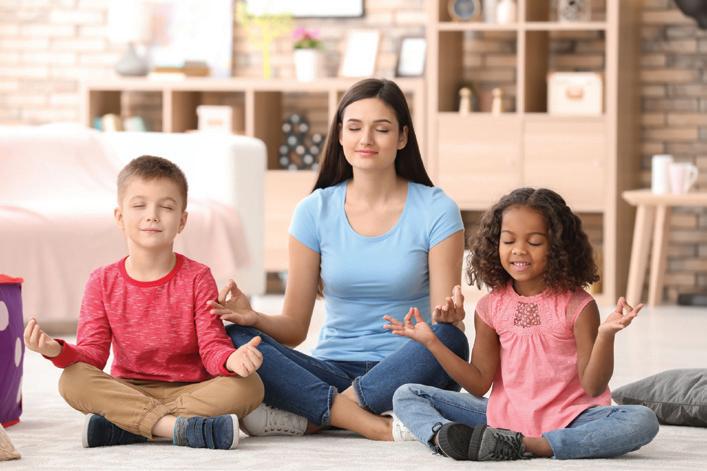
4 minute read
Mo’ Metta
Teach Children Lovingkindness Meditation
By Sandi Schwartz
We must love ourselves before we can love others and offer kindness to the world around us. This month is all about love. So why not learn a practice that will help us to better love others and ourselves. I’m referring to lovingkindness meditation, a practice so simple we can even share it with our children.
Understanding the Practice
Also called metta or compassion meditation, lovingkindness meditation is one of the most commonly practiced types of meditations out there. Quite simply, it is the practice of directing positive thoughts and well wishes to others and ourselves. It may seem odd at first, but you can easily learn it. As you sit comfortably with your eyes closed, imagine what you wish for your life. The four phrases that you either say out loud or think silently during the practice are typically: May I/you be safe. May I/you be healthy and strong. May I/you be happy. May I/you be peaceful and at ease. You repeat these wishes, directing them first to yourself and then toward different people in your life, as follows: 1. Start by directing the phrases to yourself. 2. Next, direct the metta toward someone you feel thankful for or who has helped you. 3. Now visualize someone you feel neutral about—people you neither like nor dislike. Direct the thoughts to that person. 4. Next, direct the thoughts to someone you don’t like or someone with whom you are having a difficult time dealing. 5. Finally, direct the metta toward everyone in the world: May all beings everywhere be happy.
Benefits of Lovingkindness
Meditation Practicing lovingkindness meditation ultimately changes how we relate to others and ourselves; we start to feel less isolated and more connected. According to meditation expert and author Sharon Salzberg, “When we practice it, we
acknowledge that every one of us shares the same wish to be happy, and the same vulnerability to change and suffering. We can shift the way we view ourselves and others—with kindness instead of criticism.” Scientific research shows how lovingkindness meditation leads to positive changes in the brain. Just as performing acts of kindness gives us a natural high, sitting and practicing this meditation can cause the same changes in our bodies and minds. Lovingkindness meditation brings so many amazing benefits to our lives. It: • reduces stress and anxiety; • lifts our mood and produces more positive emotions; • increases feelings of hope;
• decreases physical and emotional pain; • reduces anger; • increases positive social emotions towards new people as well as loved ones; • activates empathy; • improves social connection; • increases self-love and how we feel about ourselves
How to Share This Practice
With Children After learning about all the benefits, don’t you just want to share some lovingkindness with your kids right now? This type of meditation allows children to get in touch with their feelings. It can help guide them to send positive and healing energy to people and children in other places—even those who have hurt them, like a bully at school. Children can develop a sense of power as they gain self-love and compassion for others. The practice is special since it goes beyond cultural barriers, economic situations, educational backgrounds, and geographic locations. It is also very simple and does not require any equipment. We can teach our children about lovingkindness by helping them send the four wishes to different people in their lives. Don’t be afraid to get creative and ask your children to come up with their own loving thoughts. They can also send their wishes to favorite objects, such as a pet, television or book character, toy, or stuffed animal. You can also go

through the wishes by saying them to each other. One mother explained how she incorporated lovingkindness meditation into their family’s bedtime routine. She says “may you be happy” and then the children repeat it back to her. They go through this process a few times, repeating the different phrases. This month is the perfect time to teach your children how to spread love through lovingkindness meditation. It is also a tool that they can take with them throughout the year, helping them to feel happier, calmer, healthier, and better connected to others.
Sandi Schwartz is a freelance writer/ blogger and mother of two. Find her at happysciencemom.com.
A Kid-Meditator’s Bookshelf
Audrey’s Journey: Loving Kindness by Kerry Alison Wekelo (Zendoway, 2016) Loving-Kindness Meditation by Sami Jo (CreateSpace, 2016)
Meditation for Kids: The Loving Kindness by Olivia Brown (2016) Moose’s Mindful Mantra by Mernette Martin (Publishing USA, 2017) Zen Learns Lovingkindness by Jeremiah Lee Olson (CreateSpace, 2015)
ENJOYING OUR MAGAZINE?
Don’t Miss Out on Our Weekly FunBlast
mendo lake
FREE!
September 2020
Autism Aid Routines work Virtual Nana
Kids connect
Find a Tutor
Tips for success
Minivan Mafia
Laugh it up

